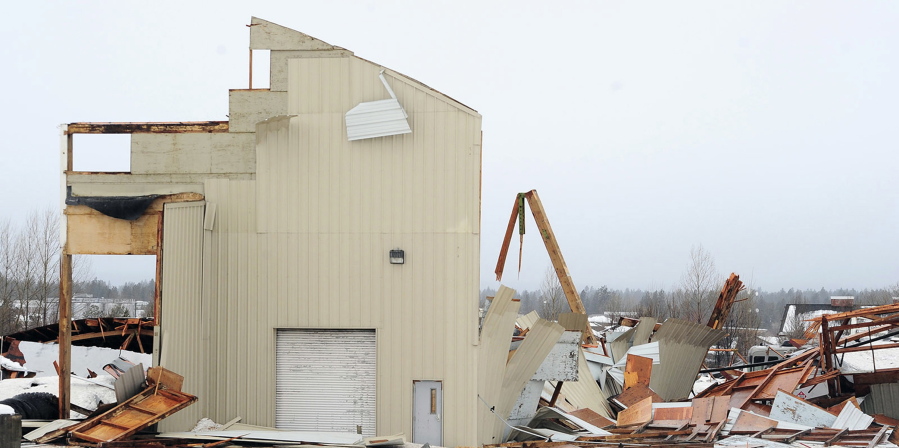BOISE, Idaho (AP) — For buildings in parts of the snow-covered U.S. West, it has become a winter where the weak do not survive.
The accumulated weight of snow has crushed an old lumber mill in Oregon, the main grocery store in a small Idaho town, a sports complex in Alaska and a conference center in Colorado, among others.
They have led to some injuries and at least one death, when the roof of a woman’s snow-laden porch in northern Idaho fell while she was underneath it, officials said. Authorities fear more collapses will come.
Storms this winter have blanketed the West and kept dumping more snow on top of it. Experts said the rare combination of greater snowfall at lower elevations and prolonged cold temperatures that allowed the snow to accumulate without melting away is partly to blame for the collapses.
The combination builds up an amount of snow that exceeds building codes set for weather expected only twice a century, said Dell Winegar, president of the Idaho Onion Growers Association, whose industry has felt the pain at its facilities.
Nearly 20 buildings that store and package onions have crashed down in Idaho and Oregon, leading prices to spike from $3.50 to $6.50 for a 50-pound bag of yellow jumbo onions.
“It’s been a heartbreak for a lot of folks,” Winegar said. “It’s hard to prepare for something that has never happened before.”
While lower elevations are getting record snow, mountains in the West are only somewhat above average, forecasters said.
But “that snow hasn’t been melting,” said Troy Lindquist of the National Weather Service. “We’re ending up with snow loads on roofs that we typically don’t see around here.”
Another possible reason behind the collapses is that settling snow does not look as substantial because it’s not as deep, fooling building owners about the weight that’s pressing on shingles and tiles.
But experts said the water density in the snow is increasing, meaning a roof that that does not appear to be holding much powder can be straining under thousands of pounds.
“They may look at the roof and say, ‘There’s not as much snow there because it settled,'” said Ron Abramovich, a water supply specialist with the Natural Resource Conservation Service who analyzes the snowpack in mountains. “But it really comes down to the amount of water in the snowpack.”
Abramovich said 20 inches of snow can weigh about 10 pounds per square foot. That means a portion of a 20-by-20 foot roof with that amount of snow would be supporting 4,000 pounds.
A former factory was bearing much more weight than that when it collapsed this month in the upscale Old Mill District of Bend, Ore.
The building, covering 7.5 acres with nearly 30 inches of snow on its roof, was a remnant of an era when two large lumber mills stood where shops and restaurants now do. It stored about 60 campers and motorhomes, said Scott Carlson, chief financial officer of Hooker Creek, a construction materials company that owns the building.
“Typically, we get a lot of snow, but it usually melts some between snowstorms,” he said, noting that new storms made it too dangerous to remove the snow.
He didn’t have a cost estimate for the damage.
In Alaska’s largest city, the 180,000-square-foot sports center called The Dome, billed as the world’s largest structure supported by pressurized air, collapsed last weekend after a snowstorm dumped more than a foot of snow on Anchorage.
Investigators were trying to determine why the roof’s thin, flexible plastic material, supported by pipes and cables, collapsed.
Higher elevations also have faced problems. In Breckenridge, Colo., a resort mountain town above 9,000 feet, the roof of a hotel conference room caved in last week under the weight of snow. No one was injured.
Worried about more collapses, Idaho Gov. C.L. “Butch” Otter signed an emergency declaration for a county where some 100 buildings have crashed down, including a grocery store, popular bowling alley and an antique shop. The state is sending inspectors to examine schools and other structures.
The only injury reported so far is a man whose leg and hip broke when a carport collapsed, said Scott Penner, spokesman for Washington County’s disaster services.



